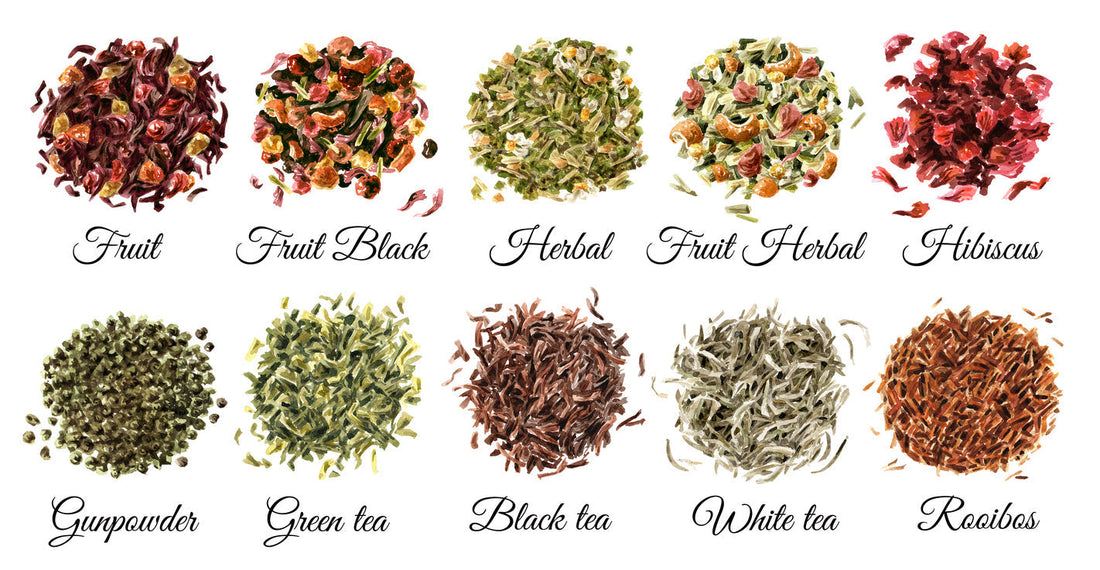
Debunking Twelve Tea Myths to Help You Become an Expert
Michele LillieTea is often a misunderstood beverage. This blog post on Tea Myths will help you separate truth from fiction about this delicious, healthy and unique beverage.
Herbal teas are actually tea.
Real tea is only made from the leaves of the tea plant, Camellia Sinensis. From the leaves of that plant, we get black, white, green, oolong, yellow, purple, and dark tea. Herbal and fruit teas are not made from the tea plant. They are made from herbs and fruits and are more correctly called Herbal Tisanes and Fruit Infusions. The only reason we call them “tea” is the fact that they are brewed in the same way as real tea.

Green teas have less caffeine than black teas.
The amount of caffeine in tea is dependent on many factors such as the varietal of the tea plant, which tea leaves are picked from the plant, whether the teas are harvested in the spring or later in the year and where the teas are grown.
It has been shown that how we brew the tea leaves can make a difference in the caffeine level in the cup. More caffeine will be extracted from the leaves when using hotter water and brewing for longer periods of time.
The subject of caffeine levels in tea is often misunderstood and is somewhat complicated. All real tea contains caffeine in the dry leaves and that caffeine infuses into the cup when it is brewed. Unless the caffeine level has been scientifically measured, no one can state which teas have less caffeine than other teas.
Herbal teas (tisanes) have no caffeine.
While most herbs are caffeine-free, there are a handful of caffeine-containing herbs such as Yerba Mate, Guayusa and Yaupon.

All green teas taste like grass.
Although a certain amount of grassiness is to be expected with a green tea, they are not all the same. Green tea flavors will vary by the country of origin, the tea processing method and how it is brewed. If you think you do not like green tea, understanding these differences can help you find one you do like.

All teas can be brewed the same.
Brewing tea is not a difficult process, but to get the best flavor without bitterness requires an understanding of how to brew the different types of tea. It is a function of using the best water at an appropriate temperature, measuring the correct amount of tea leaves and brewing for the recommended amount of time.
Those pretty little rose petals are what make your rose tea taste like roses.
Flavors are added to tea by using flavorings , which you cannot see. Most of the items added to tea such as flower blossoms and dried fruit are for visual appeal and add very little to the flavor.

Tea is dehydrating.
This myth comes from the fact that caffeine is a diuretic. This is true but it has very mild diuretic effects. Therefore, the liquid you drink in tea form counts towards your water intake.
Adding milk to tea reduces its health benefits.
Many continue to put forward the belief that adding milk to tea reduces its health benefits by reducing the level of healthy antioxidants. While there may be other reasons to not add milk to tea, there are multiple studies on both sides of the argument about antioxidant activity. In addition, even if milk does inhibit some of the antioxidant activity, it doesn’t cancel it out entirely.

Loose-leaf tea is not worth the extra cost as compared to tea bags.
With their rich and varied flavor profiles, loose-leaf teas allow you to customize your tea experience. You control the steeping time, the tea-to-water ratio, and the water temperature. Tea bags, while convenient, restrict this customization due to their pre-measured portions and typically lower-quality leaves. In addition, most loose-leaf tea can be brewed more than once, leading to less cost per cup than you might imagine.

Bottled iced teas are as healthy as brewed tea.
Bottled iced teas contain varied amounts of tea. They also often contain a significant amount of added sugar. Be sure to check the label of any bottled iced tea you purchase, or even better, brew your own iced tea.

The caffeine in tea is the same as the caffeine in coffee.
This statement is true but incomplete. Besides caffeine, tea contains theanine. This natural chemical attenuates the stimulating effects of caffeine. The combination of caffeine and theanine has been shown to improve concentration and focus.
Green tea is always healthier than black tea.
Recently, the FDA has approved real tea without any additives to be proclaimed as a healthy beverage . This is due to the healthy antioxidants that are naturally found in tea along with the lack of calories. Different types of tea will have different antioxidants in varying levels. Because of this, the healthiest tea is the one you drink the most. Perhaps the healthiest habit is to drink a variety of teas – black, green, white, oolong, etc.
Becoming a tea expert doesn't require a professional title! Understanding these twelve common myths will elevate your tea knowledge.
2 comments
Thank you for reading and for being a tea lover!!
Great information on the blog! Thank you for sharing!